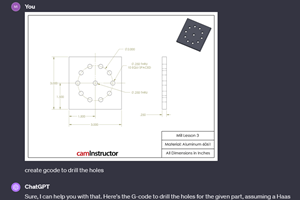CAM System Lets Shop Choose The Best Multi-Axis Machining Path
RJD Machine Products (Trenton, New Jersey) is a 20-person job shop specializing in precision machining of instrument components. They supply local manufacturing companies and research centers with precision components of prototypes to yearly contracts.
Share





RJD Machine Products (Trenton, New Jersey) is a 20-person job shop specializing in precision machining of instrument components. They supply local manufacturing companies and research centers with precision components of prototypes to yearly contracts. The high tech Princeton area requires state-of-the-art ideas and capabilities that are required to be a leader in the field.
Many of the workpieces are castings, prismatic in shape, with thin wall sections. Materials vary including cast iron, steel and brass but, primarily the shop works with aluminum. "The trick to machining castings," says RJD president Richard Roslowski, "is location. Getting a precise fixture position is key to repeatability because of dimensional variances between castings."
Once a datum is established, the shop uses multi-spindle, multi-axis positioners and pallet-changers on its CNC machines to present the workpiece faces to the spindle. "We maintain accurate feature relationships by using a minimum of part handlings," says Mr. Roslowski.
In 1994, the shop acquired an new CAM software package. Called Partmaker, the software is a product of International Manufacturing Computer Services (IMCS/PartMaker Software, Maple Glen, Pennsylvania). For the multi-axis machining operations that RJD does on instrument body castings, the software's multi-face programming capability alone makes it worth the investment, according to Mr. Roslowski.
A workpiece is programmed one face or plane at a time (up to eight). A separate window is presented for each plane. Once the operations for each face are input, the programmer can run a time study, on the software, to determine if it is more efficient to perform all operations on each plane sequentially or perform all operations for a given tool on each plane then change tools. "Most of the time it's faster to index the work than change tools," says Mr. Roslowski. "But, having a choice has saved us machining time on some jobs." Programming by plane lets RJD get multi-axis functionality from a 2 1/2 axis CAM package.
Another feature that RJD likes about this software is called ConfigPost. It lets the shop create and save custom postprocessor files, as needed, for each machine tool in the shop. Rather than purchase specific post for each machine, Partmaker uses Windows' interactive environment, that enables the shop to do postprocessor customization. RJD was able to configure output for every machine in the shop within an hour, using this feature.
Like most job shops, orders coming to RJD can vary from prototype to production runs. Jobs tend to repeat on a regular basis with maximum orders ranging up to 1,000 to 2,000 pieces. Over the almost 20 years this shop has been in business, relationships between customers have grown close enough for RJD to advise designers on manufacture-ability issues. Although there is no sales force at RJD, reputation has kept the company's 20 employees busy in overtime. Now, the shop often works with its customers to make sure part designs can be machined feasibly at RJD.
Customer drawings can be input into the CAM system through a drafting package in the software. For those customers using DXF files, these can be read directly into the Partmaker CAM software without redrawing them. "Working with DXF files lets you open the door between design and manufacturing," says Mr. Roslowski. Communication between the shop and customer allows RJD to deliver good parts.
Partmaker software has been a good investment for the shop. It was quick and easy to learn and does the CAM functions needed by RJD. According to IMCS, Partmaker is knowledge-based system, with means it retains data from part to part. Commonly used tools, drills, taps, end mills, and so on and features--such as holes, slots, and pocketscan be identified once and then called up if needed on subsequent workpieces.
Tool management functions include an inventory database for keeping track of tools. A cycles database stores repetitive cycles such as drilling, tapping, boring, chamfering and is linked to the tools database by feature description. Much of the work done in a machine shop involves hole production and finishing.
Partmaker is sold bundled with N-See solid modeling verification from Micro-compatibles. This helps the programmer determine tool path and interference points prior to sending the job to the shop floor. The idea is to catch programming errors before they reach they reach the machine. "It's a real time saver for us," says Mr. Roslowski.
The software is priced to appeal to smaller shops with a low price. It's Windows or Macintosh compatible requiring a PC hardware platform to operate. MMS
Related Content
Can ChatGPT Create Usable G-Code Programs?
Since its debut in late 2022, ChatGPT has been used in many situations, from writing stories to writing code, including G-code. But is it useful to shops? We asked a CAM expert for his thoughts.
Read MoreHow this Job Shop Grew Capacity Without Expanding Footprint
This shop relies on digital solutions to grow their manufacturing business. With this approach, W.A. Pfeiffer has achieved seamless end-to-end connectivity, shorter lead times and increased throughput.
Read MoreAdvanced Tool Paths, Simple Implementation
Programming advanced tool paths used to be a complex, time-consuming task. Canned cycles in CAM software have now made them more accessible than ever.
Read MoreLarge-Format Machining With Small Cutting Tools and Dynamic Motion
Napoleon Machine, a defense contractor that provides parts for the M1 Abrams tank, recently took advantage of a CAM feature that allowed the company to streamline its cutting strategies and program offline. Here’s how the shop cut cycle times nearly in half with its large-format five-axis machining operations.
Read MoreRead Next
Machine Shop MBA
Making Chips and Modern Machine Shop are teaming up for a new podcast series called Machine Shop MBA—designed to help manufacturers measure their success against the industry’s best. Through the lens of the Top Shops benchmarking program, the series explores the KPIs that set high-performing shops apart, from machine utilization and first-pass yield to employee engagement and revenue per employee.
Read MoreAMRs Are Moving Into Manufacturing: 4 Considerations for Implementation
AMRs can provide a flexible, easy-to-use automation platform so long as manufacturers choose a suitable task and prepare their facilities.
Read More




















